
Given figures represent the ultra structure of a typical cyanobacterial cell. Identify the following parts and select the correct option for A and B.

A. A-Naked DNA, B- Thylakoids
B. A- Thylakoids, B- Naked DNA
C. A- DNA + histones, B- Thylakoids
D. A- DNA+ histone, B-80 S Ribosomes

Answer
550.5k+ views
Hint: Cyanobacteria do not have well-defined nucleus and well- organized chromosomes. They contain single circular DNA. The cell organelles like mitochondria, Golgi complex are not seen in this bacteria.
Complete answer:
Blue-green algae or cyanobacteria are a definite group of photosynthetic bacteria that generally grows in ponds, lakes where the water is lukewarm and rich with nitrogen and phosphorus. These bacteria are mainly blue-green but it can be found in green, reddish-purple or brown colour.
Blue green algae lacks a true nucleus and membrane bound organelles. It can perform oxygenic photosynthesis and they constitute a phylum of bacteria consisting of free living photosynthetic forms called Cyanophyta. The peripheral side of BGA protoplast has the thylakoids and is termed as chromoplast in the major way.
Thylakoids incorporate photosynthetic pigments (chlorophyll a, xanthophyll, and phycobilin) in their membranes and especially function as a site for photosynthesis. The photosynthesis in blue green algae takes place in the thylakoids or photosynthetic lamellae which are flattened structures present in chloroplast.
In the cyanobacteria there is presence of nucleoids instead of true nucleus. Nucleoids contain the genetic material of DNA along with nuclear membrane and that DNA constituting nuclear membrane is known as Naked DNA. Hence the cells of cyanobacteria contain the nucleoids which is the genetic material of naked DNA. DNA contains no histone protein and it consists of 70S ribosomes.

Hence, the correct answer is option (A).
Note: Cyanobacteria are both beneficial and harmful for humans. Some of these bacteria produce cyanotoxins that are poisonous which are harmful for humans and animals whereas some cyanobacteria are used in the production of bioethanol, supplements for dietary and food colourings.
Complete answer:
Blue-green algae or cyanobacteria are a definite group of photosynthetic bacteria that generally grows in ponds, lakes where the water is lukewarm and rich with nitrogen and phosphorus. These bacteria are mainly blue-green but it can be found in green, reddish-purple or brown colour.
Blue green algae lacks a true nucleus and membrane bound organelles. It can perform oxygenic photosynthesis and they constitute a phylum of bacteria consisting of free living photosynthetic forms called Cyanophyta. The peripheral side of BGA protoplast has the thylakoids and is termed as chromoplast in the major way.
Thylakoids incorporate photosynthetic pigments (chlorophyll a, xanthophyll, and phycobilin) in their membranes and especially function as a site for photosynthesis. The photosynthesis in blue green algae takes place in the thylakoids or photosynthetic lamellae which are flattened structures present in chloroplast.
In the cyanobacteria there is presence of nucleoids instead of true nucleus. Nucleoids contain the genetic material of DNA along with nuclear membrane and that DNA constituting nuclear membrane is known as Naked DNA. Hence the cells of cyanobacteria contain the nucleoids which is the genetic material of naked DNA. DNA contains no histone protein and it consists of 70S ribosomes.

Hence, the correct answer is option (A).
Note: Cyanobacteria are both beneficial and harmful for humans. Some of these bacteria produce cyanotoxins that are poisonous which are harmful for humans and animals whereas some cyanobacteria are used in the production of bioethanol, supplements for dietary and food colourings.
Recently Updated Pages
Master Class 12 English: Engaging Questions & Answers for Success

Master Class 12 Business Studies: Engaging Questions & Answers for Success

Master Class 12 Economics: Engaging Questions & Answers for Success

Master Class 12 Social Science: Engaging Questions & Answers for Success

Master Class 12 Maths: Engaging Questions & Answers for Success

Master Class 12 Chemistry: Engaging Questions & Answers for Success

Trending doubts
What are the major means of transport Explain each class 12 social science CBSE

Which are the Top 10 Largest Countries of the World?

Draw a labelled sketch of the human eye class 12 physics CBSE

Explain sex determination in humans with line diag class 12 biology CBSE

The pH of the pancreatic juice is A 64 B 86 C 120 D class 12 biology CBSE

Explain sex determination in humans with the help of class 12 biology CBSE




